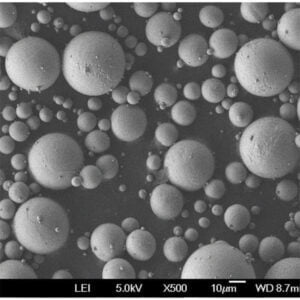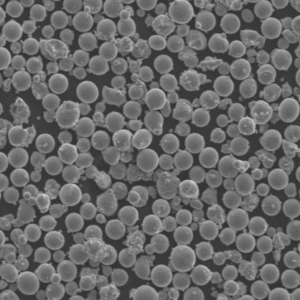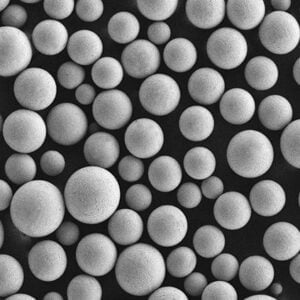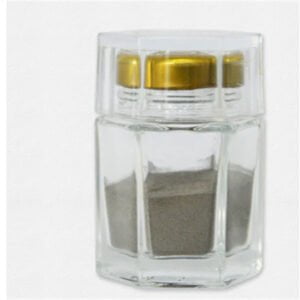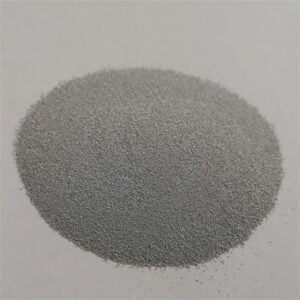니켈 기반 분말
목차
니켈 기반 분말 은 적층 제조, 표면 코팅, 용접 등 다양한 용도로 사용되는 니켈 또는 니켈 합금으로 만든 분말을 말합니다. 이 문서에서는 니켈 기반 분말에 대한 개요, 구성 및 특성, 용도, 사양, 가격, 비교 및 FAQ를 제공합니다.
개요 의 니켈 기반 분말
니켈 기반 분말은 주로 니켈과 크롬, 몰리브덴, 텅스텐 등의 합금 원소로 구성된 금속 분말입니다. 이러한 분말을 고성능 애플리케이션에 적합하게 만드는 주요 특성은 다음과 같습니다:
- 고온에서의 높은 강도와 경도
- 우수한 내식성 및 내산화성
- 우수한 내마모성
- 높은 열 및 전기 전도성
- 낮은 열팽창 계수
이러한 분말은 가스 또는 물 분무, 전기 분해, 카르보닐 분해 등의 공정을 통해 다양한 크기와 형태로 생산할 수 있습니다. 일반적으로 사용되는 니켈 합금은 인코넬, 모넬, 하스텔로이, 니크롬 등입니다.
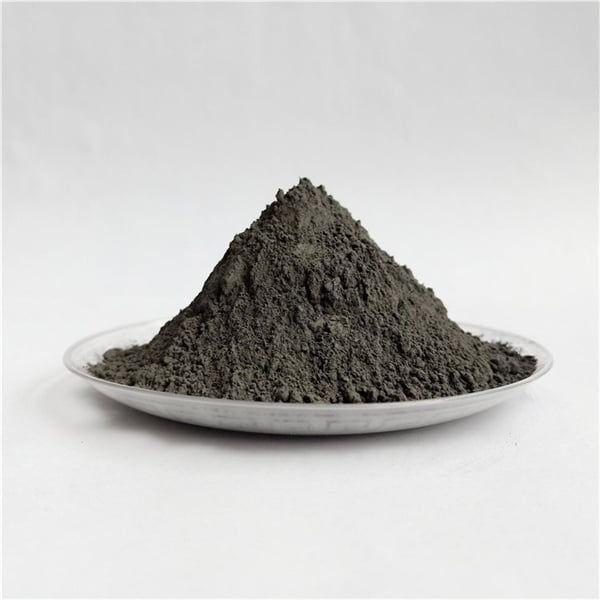
니켈 기반 분말 구성
니켈 기반 분말 은 다른 합금 원소와 함께 니켈을 주원소로 함유하고 있습니다. 일반적인 구성은 다음과 같습니다:
| 합금 | 니켈(%) | 기타 요소 |
|---|---|---|
| 니켈 | 99%+ | – |
| 인코넬 | 72% Ni, 14-17% Cr | 철, 니오븀, 구리, 알루미늄 |
| 모넬 | 63-70% Ni, 27-34% Cu | 철, 망간, 실리콘, 탄소 |
| 니크롬 | 80% Ni, 20% Cr | 철 |
| 하스텔로이 | 42-62% Ni | 크롬, 몰리브덴, 텅스텐 |
니켈과 합금의 비율에 따라 강도, 내식성, 내산화성 등과 같은 주요 특성이 결정됩니다.
니켈 기반 분말 속성
니켈 합금 분말은 니켈에 비해 뛰어난 특성을 지니고 있어 열악한 환경에 적합합니다:
| 속성 | 특성 |
|---|---|
| 고온 강도 | 1000°C 이상에서 강도 유지 및 크리프 변형 방지 |
| 내식성 | 산, 알칼리 등에 강한 보호용 산화막을 형성합니다. |
| 내산화성 | 최대 ~1100°C의 공기 중 산화 속도가 느립니다. |
| 내마모성 | 강철보다 침식, 마모, 마모에 더 잘 견딥니다. |
| 열 전도성 | 스테인리스강보다 높음, 인코넬 625의 경우 ~20W/m.K |
| 전기 저항 | 발열체에 대한 저항성이 높은 다양한 합금 제품군 |
| 열팽창 계수 | 낮은 CTE로 열충격 저항성 제공 |
유형 니켈 기반 분말의 비율
니켈 분말은 다양한 증착 방법에 적합한 다양한 유형으로 제공됩니다:
| 유형 | 일반적인 합금 | 크기 범위 | ** 형태학** |
|---|---|---|---|
| 가스 분무 | 인코넬 625, 718; 모넬, 하스텔로이 | 5 - 150 μm | 둥근, 구형 |
| 물 분무 | 인코넬 625, 718; 316L, 304L | 10 - 300 μm | 들쭉날쭉하고 불규칙한 |
| 전해질 | 니켈, 모넬, 니크롬 | 1 – 150μm | 수지상, 결정질 |
| 카보닐 | 니켈 | 0.5 - 12μm | 플레이크, 칩 |
- 가스 및 물 분무로 포장 밀도 및 유동성 향상
- 전해질은 산소 함량이 높아 다공성을 유발합니다.
- 카보닐 니켈 분말은 고순도(>99% Ni)입니다.
니켈 기반 분말 애플리케이션
니켈 합금 분말의 주요 응용 분야는 다음과 같습니다:
| 산업 | 애플리케이션 |
|---|---|
| 적층 제조 | 항공우주 부품, 터빈 블레이드, 로켓 엔진 |
| 용접 | 터빈, 공구, 금형 수리; 인코넬, 하스텔로이 접합 |
| 표면 코팅 | 부식 방지, 내마모성, 오버레이 코팅 |
| 전자 제품 | 저항기, 발열체, 도체 |
| 다이아몬드 도구 | 절단, 드릴링, 연삭용 본딩 다이아몬드 그릿 |
| 자석 | 자기 특성 개선 |
| 배터리 | Ni-Cd, Ni-MH 배터리의 니켈 전극 |
니켈 분말은 고강도 및 내식성과 같은 고유한 특성을 통해 중요한 애플리케이션을 구현할 수 있습니다.
니켈 기반 분말 사양
니켈 합금 분말은 다양한 크기와 형태로 제공되며 안정적인 성능을 위해 조성, 순도 및 일관성 사양을 충족해야 합니다.
| 매개변수 | 범위/등급 |
|---|---|
| 입자 크기 | 5μm ~ 300μm |
| 파티클 모양 | 구형, 불규칙한 조각, 플레이크 |
| 겉보기 밀도 | 2 - 5g/cc |
| 탭 밀도 | 4 - 7g/cc |
| 유량 | 15 - 25 s/50g |
| 순도 | 98.5% ~ 99.9% |
| 산소 함량 | <0.5% |
| 수소 손실 | <0.1% |
ASTM International과 같은 표준 기관은 니켈 분말의 테스트 방법 및 임계값에 대한 규격을 제공합니다:
- ASTM B162: 니켈 플레이트, 시트, 스트립 및 압연 바에 대한 표준
- ASTM B283: 가스 분무 니켈 분말 및 분말 야금 제품
- ISO 4499-4: 금속 분말 - 고온 추출을 통한 산소 및 질소 함량 측정
니켈 기반 분말 공급업체 및 가격
니켈 및 니켈 합금 분말의 주요 글로벌 공급업체는 다음과 같습니다:
| 회사 | 브랜드 | 합금 | 가격 범위 |
|---|---|---|---|
| 호가나스 | 니코파우더® | 니켈, 카보닐 니켈 | kg당 $50 - $100 |
| 샌드빅 오스프리 | Nifco® | 니켈, 구리 니켈, 니켈 철 | $75 - $250 kg당 |
| 카펜터 기술 | Cartech® | 625, 718, 690,모넬, 하스텔로이 | $100 - $500 kg당 |
| AMETEK | 초미세 니켈 | 카보닐 니켈 | kg당 $80 - $120 |
가격은 다음에 따라 달라집니다:
- 합금 등급: 인코넬 718 > 인코넬 625 > 니켈 > 모넬
- 입자 크기: 나노 분말 > 마이크로 분말
- 순도 수준: 99.9% 니켈 > 98% 니켈
- 수량 및 대량 할인
비교
| 매개변수 | 가스 분무 | 물 분무 | 전해질 |
|---|---|---|---|
| 비용 | 높음 | 낮음 | Medium |
| 순도 | 높음 - 99%+ | 중간 - 98-99% | 낮음 - 90-98% |
| 산소 픽업 | 낮음 | 높음 | 높음 |
| 파티클 모양 | 둥근 | 재기드 | 수지상 |
| 유동성 | 우수 | 보통 | Poor |
| 겉보기 밀도 | 높음 | Medium | 낮음 |
| 애플리케이션 | AM, 코팅 | 용접, 표면 코팅 | 발열체, 전자제품 |
생산 공정의 주요 차이점은 비용, 품질 및 성능의 절충으로 이어집니다.
장점 의 니켈 기반 분말
니켈 합금 분말은 다른 소재에 비해 고유한 이점을 제공합니다:
- 1000°C가 넘는 고온을 견뎌야 합니다.
- 산성 또는 알칼리성 환경에서의 부식 방지
- 복잡한 형상의 적층 가공 지원
- 다이아몬드 공구를 위한 탁월한 결합 강도 제공
- 의료용 임플란트에 대한 생체 적합성
- 제어된 확장 특성 보유
- 분말 야금에서 재활용 및 재사용 가능
제한 사항
이러한 파우더와 관련된 몇 가지 단점이 있습니다:
- 철 또는 구리 분말에 비해 비싸다.
- 취급 중 산소 오염에 민감함
- 과열되면 표면 균열이 발생하기 쉽습니다.
- 저온 압축 및 소결로 처리하기 어려움
- 열분사 시 제어된 대기 환경 필요
- 구리 대비 낮은 전기 및 열 전도성
제한을 최소화하려면 적절한 분말 취급, 보관 및 처리 방법을 사용해야 합니다.
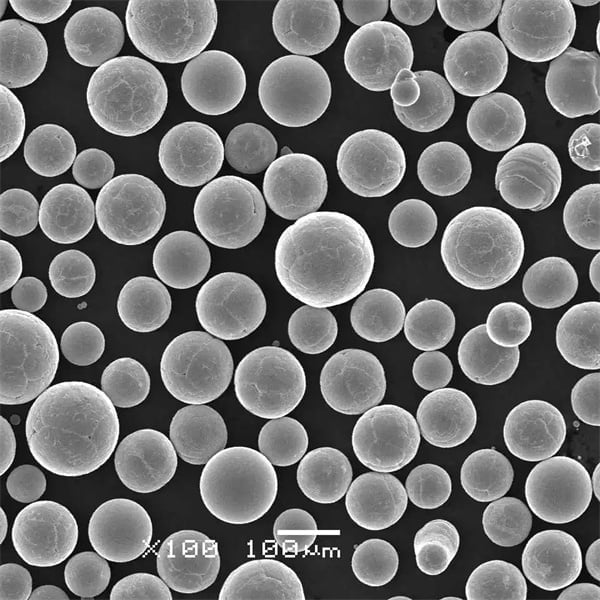
자주 묻는 질문
질문: 니켈 분말은 위험한가요?
A: 장시간 흡입하면 호흡기 감작을 일으킬 수 있습니다. 취급 시에는 마스크와 장갑 등 적절한 개인보호장비를 착용해야 합니다.
Q: 니켈 분말의 유통기한은 어떻게 되나요?
A: 밀폐된 용기에 넣어 불활성 분위기에서 보관하면 유통기한이 5년을 초과할 수 있습니다. 산소와 수분을 흡수하면 시간이 지남에 따라 품질이 저하됩니다.
Q: 열 분무에 가장 적합한 입자 크기는 무엇인가요?
A: 20-45μm는 밀도와 결합 강도가 더 좋습니다. 분말이 미세할수록 증착 효율이 떨어집니다.
Q: 자성인가요, 비자성인가요?
A: 순수 니켈은 약간의 자성을 띱니다. 철과 니켈이 포함된 니크롬과 뮤메탈을 제외한 대부분의 니켈 합금은 비자성입니다.
Q: 니켈 합금을 3D 프린팅할 수 있나요?
A: 예, 인코넬 및 하스텔로이 등급은 우수한 특성을 제공하지만 레이저 용융/소결에 최적화된 파라미터가 필요합니다.
공유
중국 칭다오에 본사를 둔 선도적인 적층 제조 솔루션 제공업체인 MET3DP Technology Co. 당사는 산업용 3D 프린팅 장비와 고성능 금속 분말을 전문으로 합니다.
관련 기사
Met3DP 소개
최근 업데이트
제품

3D 프린팅 및 적층 제조용 금속 분말
문의 정보
- 칭다오시, 산둥성, 중국
- [email protected]
- [email protected]
- +86 19116340731






